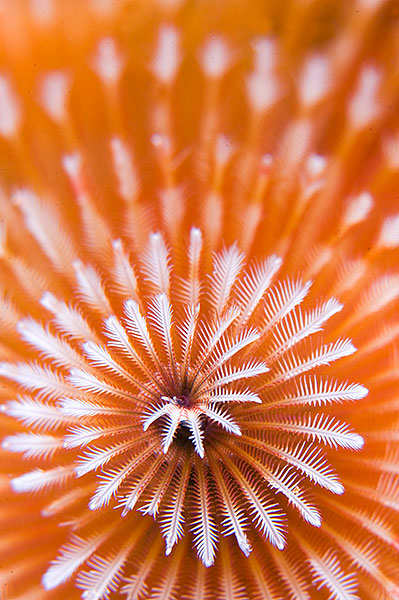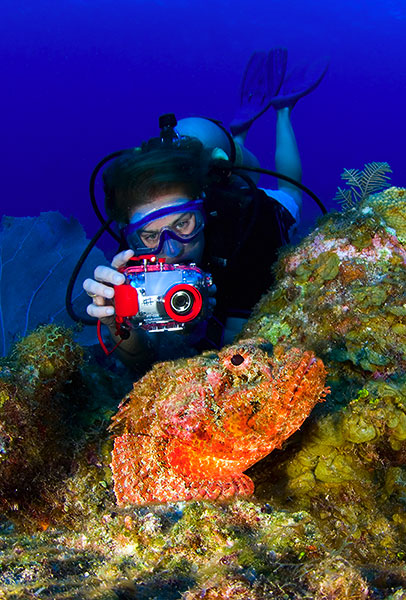When To Jump
One of the biggest hurdles facing the aspiring digital photographer is knowing which of the plethora of cameras to choose and when to get it. Digideep.com, a website dedicated to providing an overview of the digital underwater photography market, lists 773 different digital cameras and 483 digital camera housings! It is a confusing and intimidating ocean of choice. The selection problem is compounded when the new photographer then discovers that the camera they have been tirelessly researching is about to be replaced. Suddenly they are faced with the conundrum of waiting for the new model or buying the current one. And whenever you decide to look, there is always the promise of a new model just round the corner.
This is a topical problem in the DSLR segment, where the two major players, Canon and Nikon have both introduced new pro-sumer “pocket-battleship” cameras in the second half of 2005. These cameras are smaller than the pro bodies, but pack in nearly all of their features. It is a tier in the product line-up that has always appealed to underwater photographers, when even in the film days both the pro-sumer Nikon F90x and F100 were far more popular than the pro level F4 and F5. A good small camera equals a small housing and is always better than a good big camera for underwater photography.

Inexpensive accessories like close-up dioptres can really transform
your photos for a fraction of the cost of buying a new camera. © Alex Mustard
Unsurprisingly, as we wait for all the housings to become available there is much debate about whether the Nikon D200 or the Canon 5D is the better choice or whether these cameras are really worth the upgrade. I won’t attempt to answer that here, since I have not shot either underwater yet. But it does remind me of the perpetual conundrum of when is the right time to jump and upgrade to a new system.
Help is at hand, so it seems, in the form of internet forums, where you can actually ask photographers who actually use these cameras what they think of them. The underwater photography forums here are Wetpixel are particularly helpful, and you will get advice that is actually relevant to the peculiarities of aquatic snapping. But beware should you wander over to the general photography fourms, where many of the posters seem to have the same prejudiced brand dedication as football supporters at a local derby match.
These gear-heads, known online as measurbators because of their love of camera specifications over photography, justify their actions saying it is all part of the fun. They point out that the very existence of the forums is to debate the minutia of the tech specs. But the side effect of their vilified arguments is to leave the new photographer scared to commit to a particular camera because someone, somewhere, has said they don’t like it.
The truth is simply that almost all of the current cameras are very capable. Even the ones that the measurbators consider totally worthless can still take stunning images. A good tip for spotting a good underwater camera is to see how many housing manufacturers support it (although I can think of a couple of exceptions to this rule).

Your underwater photos will improve much more by getting underwater
and shooting than worrying about when to upgrade. © Alex Mustard
The measurbators would be better feeding their need for toys, which admittedly has always been part of the attraction of taking pictures underwater, by concentrating on buying lenses and accessories that increase the technical capabilities of their kit. The types of pictures we can take underwater are limited by the physics of shooting in a murky, particle filled, predominantly blue environment, and we need certain kit for certain shots. The intelligent measurbator’s would be better off drooling over lenses, strobes or decent strobe arms rather than megapixels.
My final point is much more encouraging. Put simply the correct underwater photographic technique is far more important for getting good images than having the latest and greatest camera. I think that we can all fall into the trap of chasing the latest and greatest camera, when a look at our own technique and approach is probably a faster (and cheaper) way to improve our image quality. My advice to new digital underwater photographers is don’t get too worried about when to jump to a new camera. Just buy a camera, get it underwater and shoot, learn and improve. I can promise you it is much more fun than sitting on the fence, worrying and waiting for the next upgrade.
—
Dr. Alex Mustard
Talking Megapixels
Digital has ushered in many changes to underwater photography. The aim of this column is to discuss both the important and more frivolous consequences of these changes to the status quo of our consuming pursuit.